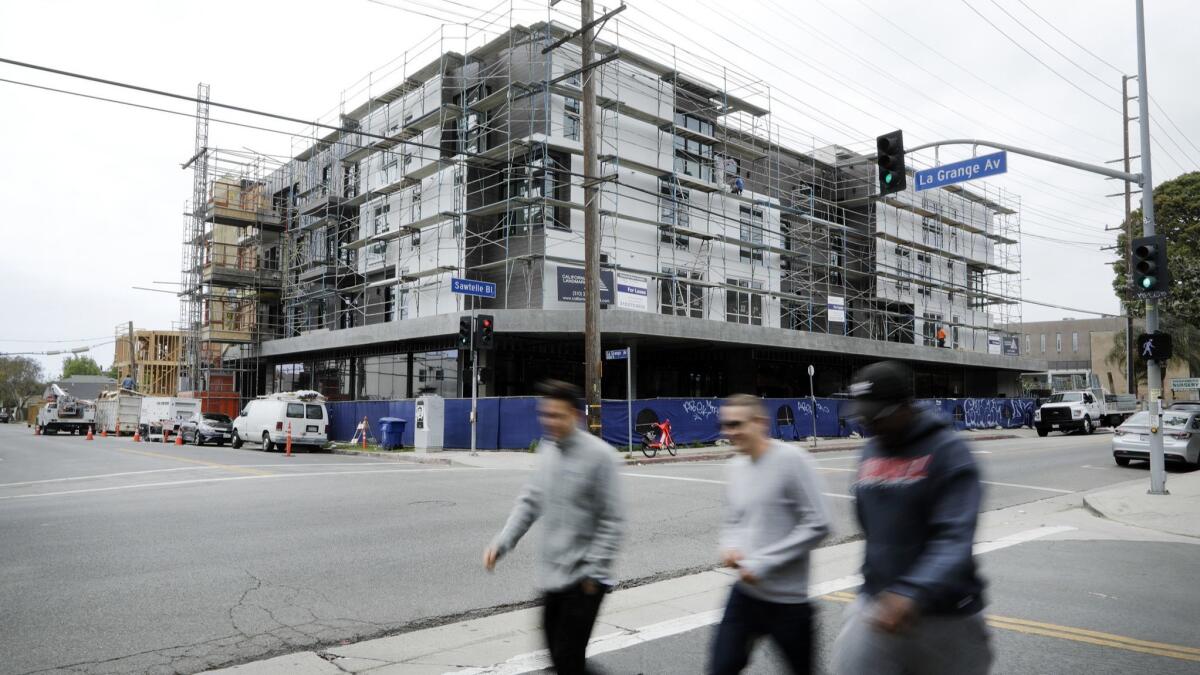Editorial: Gavin Newsom tells Southern California to plan for housing. A lot more housing

- Share via
If Southern California leaders were questioning whether Gov. Newsom is serious about ending the state’s housing crisis, he’s given them a very clear answer.
He is.
His administration recently overruled a long-term housing plan from Southern California leaders that vastly underestimated the number of homes needed to ease the existing shortage and to shelter the next generation of Californians. Instead, the state Department of Housing and Community Development declared that cities and counties in Southern California will have to plan for the construction of 1.3 million new homes in the next decade. That number is more than three times larger than what local elected officials had wanted to commit to.
By overruling Southern California leaders’ slow-growth impulses, Newsom made clear that his administration is going to be far more aggressive in requiring cities and counties to make room for new housing. And that’s a very good thing.
Housing and Community Development is required to set housing targets under the state’s “fair share” housing law, which instructs cities and counties to plan and zone every eight years for enough development to house their share of the state’s growing population. Cities aren’t required to build the homes — that’s up to the private sector — but they have to plan and zone for them.
For decades, some local governments have looked for ways to shirk that responsibility, bending to complaints from not-in-my-backyard groups that want to hold down traffic, discourage development and preserve the region’s low-slung suburban character. That’s one reason California has a deep housing shortage that is fueling poverty, displacement and homelessness.
As the housing crisis has worsened, however, state officials have begun to exert more authority. In recent years, state lawmakers began passing bills to add teeth to the fair share housing law. Newsom has also sought to strengthen the process with penalties of up to $600,000 a month for cities that refuse to zone enough land to accommodate sufficient housing for low-income families as well as for those who can afford the market’s going rate.
At the heart of the fair share process is the estimate each community makes for how much housing it needs. A higher number means cities have to zone for more housing, a portion of which has to fill the need for affordable units.
In June, the board of the Southern California Assn. of Governments, which is composed of city and county elected officials from across the region, voted to set a woefully low estimate for the amount of housing the area would need: 430,000 homes by 2029. Housing advocates and some regional leaders, including Mayor Eric Garcetti, complained that such a lowball target would only exacerbate the housing shortage that is driving up rents and home prices.
The Newsom administration heeded those complaints and, fortunately, the state sets the housing target for each region. And although 1.3 million new homes in Southern California between 2021 and 2029 is ambitious, it’s still less than some advocates and experts say is necessary.
That works out to about 162,000 new units a year across the SCAG region, which is home to half the state’s population. The entire state of California has averaged only 80,000 new homes a year over the last decade. But state law demands a target that’s aggressive, both to address the existing shortage created by decades of insufficient construction and to meet the needs of the growing population.
SCAG will have to decide how to spread the planning for 1.3 million units across its jurisdiction. To meet the target without sprawling deeper into open space, cities will have to plan for more multi-family developments, including apartments, condos and townhomes. That will be a big change in some communities that have refused to allow anything but single-family houses.
But Southern California, along with other urban areas around the state, has to transition to greater density to ease the housing shortage. It makes sense to concentrate denser housing near mass transit and jobs so people can get around without driving, which would ease traffic congestion and cut the vehicle emissions that are polluting the air and fueling global climate change.
For too long, Southern California leaders have tried to preserve a landscape of cars and freeways and single-family homes, no matter the environmental and economic consequences for the next generation. That won’t fly anymore, especially if the governor will keep pushing cities to say “Yes in my backyard.”
More to Read
A cure for the common opinion
Get thought-provoking perspectives with our weekly newsletter.
You may occasionally receive promotional content from the Los Angeles Times.










